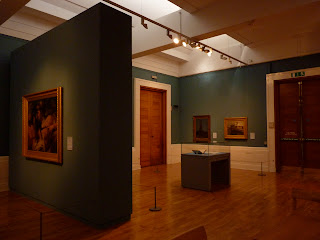This is an artist that Amanda suggested to us and also introduces a new theme into our exhibition.
The theme is facadism:
"
Façadism (or
Façadomy[1]) is the practice of demolishing a
building but leaving its
facade intact for the purposes of building new structures in it or around it.
While there are aesthetic and historical reasons for preserving building facades, the practice of facadism is often seen as a compromise between
property developers who need to develop properties for modern uses and standards and
preservationists who wish to preserve buildings of historical interest. It can be regarded as a compromise between
historic preservation and
demolition - and thus has been lauded as well as decried.
There is sometimes a blurred line between
renovation,
adaptive reuse and
facadism. Sometimes buildings renovated to such an extent that they are "skinned", preserving the exterior shell and additionally used for purposes other than what they were originally intended. While this is equivalent to facadism, the difference is typically retention of roof and or floor structures, maintaining a credible link to the original building. In contrast, facadism typically involves retaining only one or two street facing walls for purely
aesthetic and decorative purposes." (wikipedia)
Examples:


Stéphane Couturier has been exhibiting different photographic series since 1994: the first one,
Archéologie urbaine, is focused on urban spaces undergoing transformation. Next came
Villes génériques,
Landscaping and lastly
Melting Point, inaugurated with work on the Toyota factories in 2005. The city, industry, built landscapes are, for Stéphane Couturier, a way of questioning the relationship of the work and the subject represented. This dual aspect - the documentary investigation of the inseparable from the plastic research - characterises all his photographic work.
Thus, through the approaches that Stéphane Courturier proposes, the photographic subject seems to be perceived as a living organism, in perpetual evolution made up of successive layers. The accumulation of materials and colours, the remarkable frontality of the compositions makes it possible to dramatise the site that he photographs. Planes are crushed, the whole is treated in flat areas, in this way eliminating any architectural perspective.
In
Melting Point, the idea is to make the documentary aspect of the photo drift, to go beyond its narrative dimension, while keeping the documentary elements that compose it intact: reality is no longer made up of isolated things, with fixed geometric forms, but becomes a reality of flow, in continuous motion and transformation.
In 2006, Stéphane Couturier exhibited the series
Chandigarh replay, in which Le Corbusier's architecture is merged with his plastic work. He has continued to visit major metropolises (Brasilia, Havana, Barcelona), before offering today new developments in the plays between opacity and transparency, in heightening the intimately entwined dimension of the Festival d'Avignon and the architecture of the Cité des papes.
Couturiers photographs, whether of construction sites in Berlin, demolished buildings in Havana, or an automobile assembly plant in Valenciennes, are all about transformation, a subject he explores with a strong sense of design and composition and a brilliant sense of color. Couturier began his career as an art photographer in his native Paris in the early 1990s and has since made significant bodies of work in Dresden, Berlin, Seoul, Moscow, Beijing, and most recently Havana. His images are characterized by a vast array of visual information and a conception that separates him from his contemporary German counterparts. He searches for visually complex sites exhibiting dynamic vertical and horizontal lines, elegant curves, and brilliant effects of light and indigenous color.
(http://poulwebb.blogspot.com/2011/02/stephane-couturier-photography.html)































































